Bald Caps With Renata Gilbert
Friday, April 29, 2022
One of The Iver Makeup Academy’s brilliant award-winning Tutors Renata Gilbert explains Bald Caps and their use in Film and TV. With over 20 years’ experience in the industry, working on well-loved TV dramas and iconic films, she is an “all-rounder” artist, as they say in the business, working with hair, makeup and prosthetics.
What is a bald cap and what is it used for?
A bald cap is what makes actors appear bald and can be combined with a ‘thinning wig’ to look as if an actor is losing their hair; a key element in the process of ageing an actor, illnesses and hair loss conditions.
Bald Caps are also used to create different head shapes to realise fantasy creatures such as aliens or Sci-Fi.
There are 2 main kinds of bald caps, the most used are Vinyl and Silicon. Vinyl Bald Caps cost around £20 whereas silicon bald caps cost about £1,500 and are bespoke, created and cast to an individual’s head.
For both types, the art is in the preparation. Creating the perfect hair wrap is essential by following the head shape, smarming the hair down as flat as it can go and keeping the shape of the head is essential for this.
Silicon bald caps tend to be used in higher-budget films and have a translucency that looks more effective which is much harder to replicate when using Vinyl caps. Anne Hathaway had a Silicon bald cap cast for her role in The Witches.
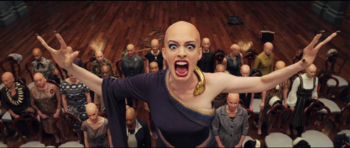
(IMDb, The Witches, 2020)
What distinct types of bald cap are there? How do you know which is the right one to use in each circumstance?
There are Vinyl, plastic, latex and silicon, each have their pros and cons, price being a major factor. Big budget productions may use a Silicon bald cap because they can afford to do so and get that “translucency” previously mentioned. However, all types still need artistic and technical skill too, it will come down to the artists preference due to budget.
What are the techniques of applying a bald cap? Do techniques vary depending on which type of bald cap use?
For any type of cap, a major skill is in the hair prep and how well it has been wrapped in order to be able to create a smooth head shape which is crucial to the result.
The varieties of Bald caps have slightly different application techniques. The Silicon cap is created to blend seamlessly onto the actor’s face and because it is cast, it should fit like a glove and in theory should be an easier application.
Prosthetic artists usually use a vinyl bald cap under a silicon one to ensure the hair is as flat as possible to create a smooth head shape, and to be able to stick the silicon bald cap to the vinyl for an even better application.
All types of bald caps need to be glued onto something and with long hair often the double cap technique is deployed so the bottom cap is stuck on the skin around the hairline and then the other cap is fully stuck on top of the first cap.
Vinyl bald caps can be taken over the eyebrows to lose that hair too or to create a fantasy character so that new eyebrows can be attached. example to create an alien effect and then airbrush on the desired look.
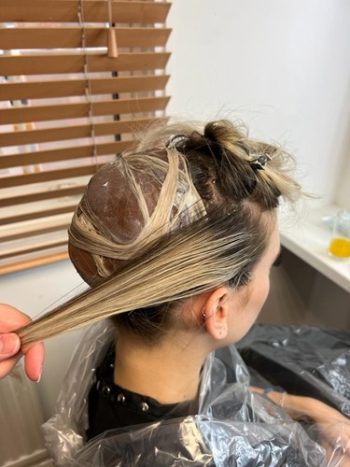
(Bald Cap Hair Wrap)
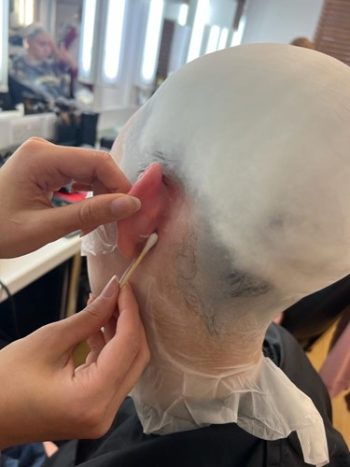
How long does the bald cap application take?
A vinyl bald cap is anything from 45 minutes to 3 hours but depends on many factors including the type of hair being covered, what the finished look needs to be and what time and budget is available to create it.
Removing a Bald Cap is a much quicker process, around 45 minutes to take off.
Bald Caps should last 10-12 hours but the mobility of the face can be an issue. Actors can be very expressive so it may require touching up during the film day. It’s important to be aware that the actor’s skin can get sore when applying daily.
What factors do you have to consider when applying a bald cap?
Considerations that need to be factored are what will the Actor be doing during filming, what location you are filming in i.e., heat, cold, wet, dry, action shots, how long it will be on for, any allergies and how much hair the actor has that needs to be wrapped etc.
If it needs to be used on a stunt double these need to match so the importance of creating a good head shape and not using pins and grips as health and safety is a big factor when working with Stunt doubles.
Things to consider are when people sweat, allergies (we can change the glues we use) if they have consumed alcohol the night before as this can affect the durability of the glue as alcohol sweated out can cause the caps to come unstuck.
With vinyl caps, often the back of the head and top of the neck are areas that don’t always look as realistic specifically when creating the skull shapes, however costumes can be of use to disguise the back of vinyl caps if need be. If the film has a lot of shots from the back or close-ups of the head, it can be extremely hard to disguise, and you can tell it isn’t visually right so in this situation silicon is better. Actors can go in the water with a bald cap, but it really isn’t ideal.
How do you make the bald cap look real?
This can be achieved by blending edges where it meets real skin, creating a realistic head shape and colouring the cap to be identical to real skin tone. Also as mentioned before make sure the hair is flat and wrap the hair to simulate the shape of the head, you don’t want any height on top of the wrapped hair.
Application is key so there are several different techniques, such as making sure the cap is as snug as possible, however too tight can cause the cap to wrinkle at the edges, be seamless at the front, and a beautiful, realistic shape at the back which isn’t bag. Once stuck onto the head, it’s about blending and colouring. Good application is totally skill-based; practice makes perfect.
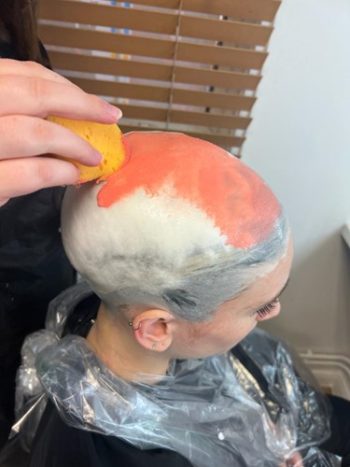
(Bald Cap Base colouring with PAX)
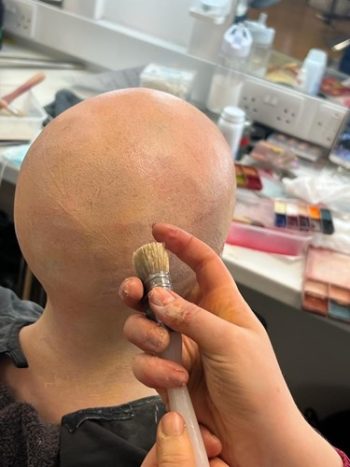
(Bald Cap Colouring using flicking technique)
What are the different elements of bald cap application and how long does it take? (i.e., tools and materials)?
Vinyl Bald caps are translucent, you need to block out the original hair colour, you need to match base tones and use alcohol palettes to splatter colour onto them in a realistic manner. Nobody has a one-colour tone to their skin, so this is created by flicking layers of colour to create realistic skin tones.The cap itself needs to be stuck using flexible acrylic glue or silicon glue to apply.
What are things which can go wrong when applying a bald cap?
Applying a Bald Cap is a tricky process, and many things can go wrong along the way from the cap splitting on application to the edges lifting once it has been on the actors for several hours. The ‘close up’ is usually the last shot of the day and the shot that requires the bald cap to look perfect.
If the cap does split on the application, it’s easier to put another one on than to try and fix it.
As the day goes on and if it’s hot, the edges can lift but it’s how you deal with these issues, learning how to apply a bald cap you can pick up quickly but it’s troubleshooting the issues that is the trick to becoming an experienced and much sought-after bald cap Artist.
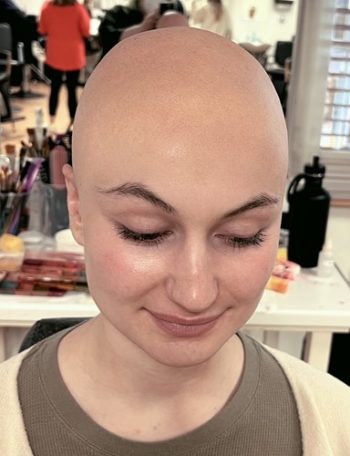
(Bald Cap Completed and Finished look – Jess Heath)
Some of the films Renata has worked on that has involved Bald Caps:
- Antman 3 – Quantumania over 60 baldcaps on various aliens.
- The Witches
- Men In Black International
- Jupiter Ascending
- Unforgotten – Chemo patient
- Holmes and Watson – John C Reilly’s stunt double
- Age of Ultron – Vision stunt double
- BBC Series, Hollow Crown Henry V – Boiling oil on to a soldier.

(IMDb, Men In Black International, 2019)
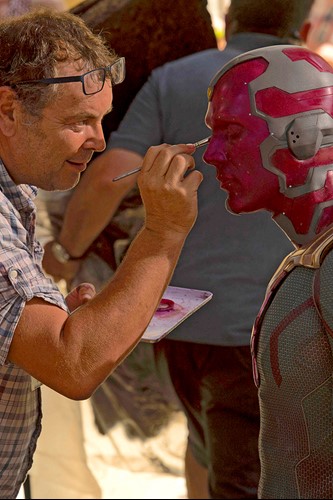
(Jeremy Woodhead, Hair and Make-Up Designer, Age of Ultron, Vision – Paul Bettany)
Want the opportunity to be taught by our award-winning teaching team – view our variety of courses here.
Also join us for our Virtual Open Day and Taster Course to gain further insight into the industry.
